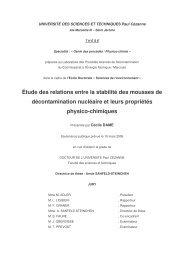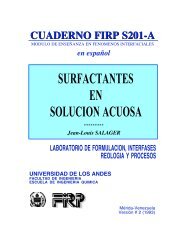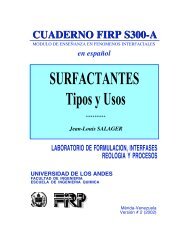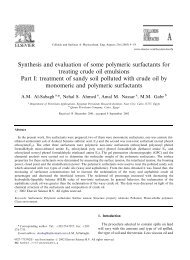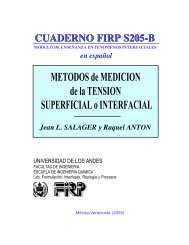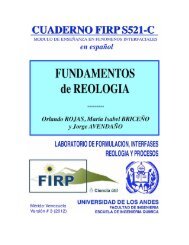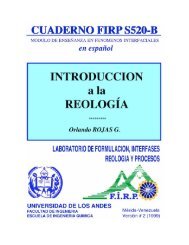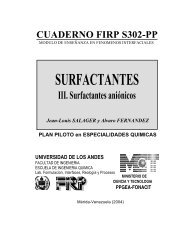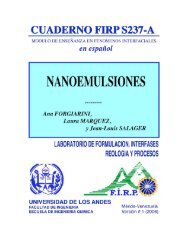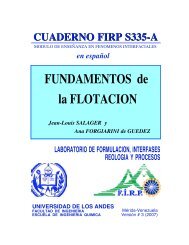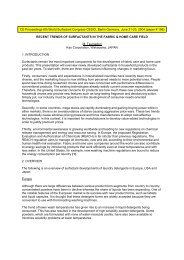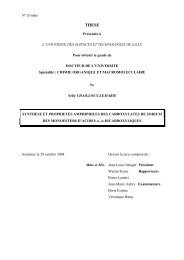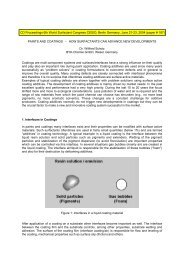Solubilization-emulsification mechanisms of detergency
Solubilization-emulsification mechanisms of detergency
Solubilization-emulsification mechanisms of detergency
You also want an ePaper? Increase the reach of your titles
YUMPU automatically turns print PDFs into web optimized ePapers that Google loves.
C.A. Miller and K.H. Raney/Colloids Surfaces A: Physicochem. Eng. Aspects 74 (1993) 169-215 191<br />
ducted to determine whether formation <strong>of</strong><br />
intermediate microemulsion phases containing a<br />
high proportion <strong>of</strong> oil could be obtained at<br />
temperatures lower than those for C 12E 5 alone.<br />
However, despite exhibiting phase behavior in<br />
the absence <strong>of</strong> oil similar to that <strong>of</strong> C 12E 4, the<br />
C 12E 5-C 12E 3 mixture behaved in a way<br />
intermediate to the behavior seen with C 12E 4 and<br />
C 12E 5 upon being contacted with hexadecane.<br />
Also, the microemulsion phases formed at<br />
various temperatures when the C 12E 5-dodecanol<br />
system contacted oil were essentially unchanged<br />
from those seen in the C 12E 5 system without any<br />
additive present. For example, rather than<br />
forming a middle-phase microemulsion with<br />
hexadecane at 30ºC, the two systems formed<br />
oil-in-water micro-emulsions. The contacting<br />
temperature had to be increased to 40ºC in the<br />
case <strong>of</strong> the C 12E 5-C 12E 3 System and 50ºC in the<br />
case <strong>of</strong> the C 12E 5-dodecanol system before<br />
middlephase microemulsion formation was<br />
observed. These differences between the two<br />
systems were attributed to differences in<br />
partitioning <strong>of</strong> the additive and the more<br />
water-soluble C 12E 5 between the oil and the<br />
microemulsion phases. The observed differences<br />
between the two additive systems would be less<br />
if smaller quantities <strong>of</strong> oil relative to the<br />
surfactant solution had been present.<br />
6.2. Water-alcohol ethoxylate-triglyceride<br />
(+ hydrocarbon) systems<br />
Triolein is a pure triglyceride suitable for use<br />
as a model for kitchen soils such as vegetable<br />
oils. Dynamic contacting studies similar to those<br />
described above for hydrocarbons were<br />
performed with triolein using aqueous solutions<br />
containing the three alcohol ethoxylates C 12E 3,<br />
C 12E 4 and C 12E 5 [48]. As described in the phase<br />
behavior section, ternary triolein - water-non-<br />
ionic surfactant systems exhibit different phase<br />
behavior than those containing straight-chain<br />
hydrocarbons. Specifically, the large size <strong>of</strong> the<br />
triolein molecules inhibits solubilization and<br />
formation <strong>of</strong> microemulsion phases.<br />
At low temperatures, schematic phase<br />
behavior like that shown in Fig. 8 is observed in<br />
which two three-phase regions are present in the<br />
ternary diagram. At these temperatures, the<br />
surfactantwater mixture is a dispersion <strong>of</strong> the<br />
liquid crystal La in water. When this dispersion<br />
is contacted with triolein, a water layer forms<br />
between the liquid crystal and the oil, and<br />
extensive spontaneous <strong>emulsification</strong> occurs in<br />
the oil phase [48]. This behavior can be<br />
explained in terms <strong>of</strong> a diffusion path which<br />
passes below the bottom three-phase region in<br />
Fig. 8. Spontaneous <strong>emulsification</strong> occurs in the<br />
oil phase due to passage <strong>of</strong> that diffusion path<br />
segment across the two-phase water-oil region.<br />
In general, insufficient surfactant is available at<br />
the interface to form an intermediate L 3 or D'<br />
phase due to the high solubility <strong>of</strong> non-ionic<br />
surfactants in triolein at these conditions. At still<br />
higher temperatures where C 12E 3 and C 12E 4 are<br />
in the form <strong>of</strong> aqueous dispersions <strong>of</strong> L 3 (greater<br />
than 30ºC for C 12E 3 and 55ºC for C 12E 4), similar<br />
behavior occurs except that even more vigorous<br />
spontaneous <strong>emulsification</strong> is observed.<br />
C 12E 5 exhibited behavior at approximately<br />
65ºC quite comparable to that observed with<br />
hydrocarbon systems near the PIT. In fact, as<br />
shown in Fig. 10, the D phase in that system<br />
contains almost equal volumes <strong>of</strong> triolein and<br />
water at 65ºC. When a concentrated lamellar<br />
liquid crystalline dispersion contacted triolein at<br />
that temperature, the D phase formed, first as<br />
lenses along the water-oil interface, then as a<br />
continuous layer. A schematic diffusion path<br />
corresponding to this behavior is shown in Fig.<br />
29.<br />
The dynamic contacting <strong>of</strong> C 12E 4. solutions<br />
with oil mixtures containing varying proportions<br />
<strong>of</strong> triolein and hexadecane was also studied<br />
[48]. For 3/1 hexadecane-triolein mixtures,<br />
behavior comparable to that found with the pure<br />
hydrocarbon system was obtained. Similarly,<br />
3/1 triolein-hexadecane systems behaved in the<br />
contacting experiments like the pure triglyceride<br />
system. However, contacting <strong>of</strong> the concentrated<br />
liquid crystalline dispersion at 38ºC with a 1/1<br />
mixture <strong>of</strong> triolein and hexadecane resulted in<br />
the formation <strong>of</strong> transient middle-phase<br />
microemulsion droplets. The failure to form a



